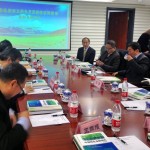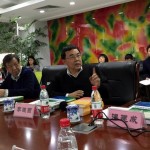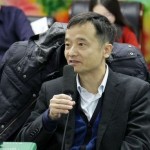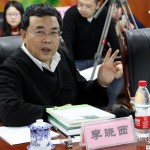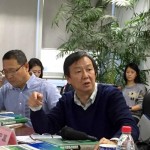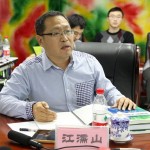By Tong Zhang, bostonese.com
Beijing, Dec. 8, 2014, — Green Development Index Report Series launched successfully today at China National Radio New Media Building in Beijing. Human Green Development Report 2014(Chinese-English Edition), China Green Development Index Report 2014_Regional Comparison (Chinese-English Edition) and China Green Finance Report 2014 were released to public by the research team of Prof. Li Xiaoxi, who is a Harvard Fellow, the principal investigator of the green development index report series, Deputy Director of Beijing Normal University (BNU) Academic Committee, and Academic Adviser of Southwestern University of Finance and Economics (SWUFE).
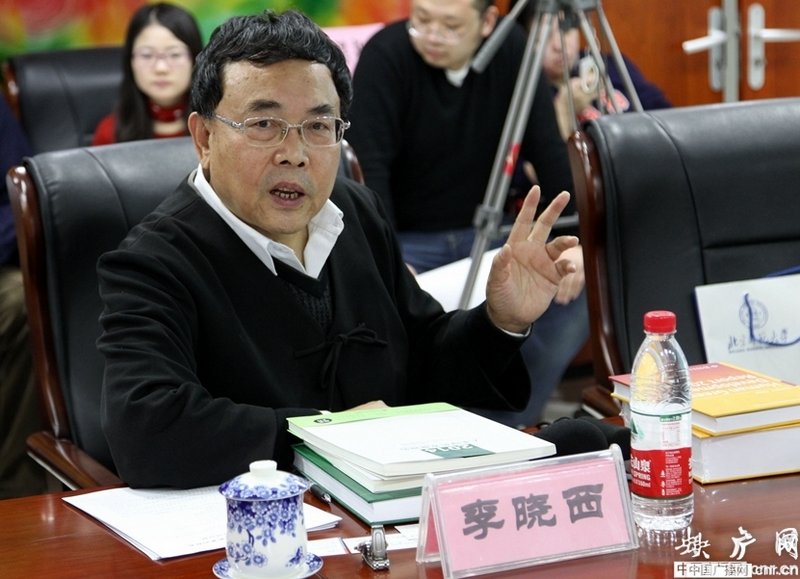
Prof. Li Xiaoxi Released the Report (photos from cnr.cn).
Lu Zhongyuan, member of the national committee of CPPCC, Ex Deputy Director of Development Research Center of the State Council; Cao Wenlian, Dean of International Cooperation Center of National Development and Reform Commission; Prof. Fu Jun of University of International Business and Economics; Prof. Wang Huiyao, Director General of Center For China & Globalization; Prof. Zhou Muzhi of Tokyo Keizai University; Jiang Rushan, Chef Economist of GEDA Hong Kong joined the launching ceremony. The launch was co-sponsored by School of Economics and Resource Management of Beijing Normal University and China National Radio.
In the conference, Prof. Li Xiaoxi, the principal investigator of the green development index report series, Deputy Director of BNU Academic Committee, and Academic Adviser of SWUFE, introduced the research background of the report series and their features respectively.
Picture 1: Launch Scene; Picture 2: Prof. Li Xiaoxi Released the Report; Picture 3: Doctor Pan Jiancheng Released Report (photos from cnr.cn).
Human Green Development Report 2014
Prof. Li Xiaoxi presented the research conclusions of Human Green Development Report 2014. In the report, the human green development is measured in two dimensions, i.e., social and economic sustainable development, as well as sustainable development of resources and environment, which is also summarized as the primary goals and basic conditions of adequate nutrition and drinking water, health and sanitation, education and poverty alleviation, bright blue sky, clear clean river, lush green land, and biological coexistence. The Human Green Development Index (HGDI) of 123 countries are comprehensively measured and the HGDI rankings are conducted using 12 fundamental indicators, namely extreme poverty, drinking water, education, sanitation, health, income, energy, climate change, air pollution, land, forest, and ecology. The measuring results show that a country’s performance in the human green development tends to be highly related with its economic development stage. Most of the top places in the ranking are occupied by the developed countries, with Sweden in the first place, while the newly industrialized countries and other developing countries remain at a relatively low human green development level, with the last 10 places in the ranking almost all African developing countries. China ranks in the 86th, which indicates that China shoulders great responsibilities and has a long way to go in the green development field.
More than 20 years since the United Nations Development Programme (UNDP) launched the Human Development Index (HDI) to show concern for the fair survival and development of human beings, and at a time when climate change and environmental deterioration pose unprecedented threats to mankind, a G, standing for Green, is added to HDI to form HGDI. This ingenious index tries to provide a simple check-up for the human-Earth dual-sustainable development (DSD), and manifests in a more intensive manner the concern for the global crisis confronting the human race.
Human Green Development Report 2014 is jointly conducted by School of Economics and Resource Management of Beijing Normal University (BNU) and Institute of Development Studies at Southwestern University of Finance and Economics (SWUFE).
Mr. Achim Steiner, United Nations Under-Secretary-General and United Nations Environment Programme (UNEP) Executive Director, expressed his appreciation and encouragement to our research on human green development. Prof. Jeffrey Sachs of Columbia University, Special Adviser to the United Nations Secretary-General and Director of UN Sustainable Development Solution Network (SDSN), who commentsed that this report is “a very important contribution to the SDGs”. The HGDI is to mirror the level of green development and encourage countries to achieve the most sustainable strategies befitting their own conditions and stage of development, to facilitate the development of SDGs, and to inspire common progresses in the process of global sustainable development.
The Chinese Edition of this report is published by Beijing Normal University press and the English Edition is also published globally by the Springer.
China Green Development Index Report 2014_Regional Comparison
Doctor Pan Jiancheng, deputy director of China Economic Monitoring & Analysis Center of National Bureau of Statistics of China, introduced the framework and Green Development Index indicator system of report 2014. He also announced the ranking result about 30 provinces and 100 cities and presented the recent progress and changes of different provinces and cities through Green Development Checkup.
According to the ranking of Green Development Index of provinces, the top 10 provinces in 2014 were Beijing, Qinghai, Hainan, Shanghai, Zhejiang, Inner Mongolia, Fujian, Tianjin, Jiangsu and Shanxi. The bottom 3 provinces were Ningxia, Gansu and Henan. In addition, there were 17 provinces’ Green Development Index higher than the average level. The results also indicated that Eastern provinces had the highest level of green development and stood out in terms of the Green Degree of Economic Growth. Western provinces enjoyed a distinct advantage in resources and the environment which might be dominant factor supporting regional green development. The green development level of three northeast provinces and central provinces was to yet to be increased.
According to the ranking of Green Development Index of cities, the top 10 cities were Haikou, Shenzhen, Karamay, Wuxi, Qingdao, Kunming, Zhanjiang, Yantai and Changsha. The bottom 5 cities were Qiqihar, Anshan, Xining, Jinchang and Lanzhou. In addition, there were 49 cities’ Green Development Index lower than the average level. What’s more, some cities in the top-ranking also had shortcomings. For example, Beijing and Changzhou got a higher rank in Green Degree of Economic Growth, but a lower rank in Carrying Capacity Potential of Natural Resources and Environment. Haikou and Kunming got a higher rank in Carrying Capacity Potential of Natural Resources and Environment, but a lower rank in Green Degree of Economic Growth. Guangzhou and Jining only got a higher rank in Support Degree of Government Policies.
A questionnaire survey about public satisfaction with urban green development of 38 cities was conducted in the report 2014. The questionnaire is designed to collect the feedback of local residents on the environment and infrastructure of the city and the green actions taken by the government. The questionnaire survey was a supplement for the statistical analysis, which will help us to get a full picture of how green development goes in the evaluated cities. The top 10 cities by public satisfaction were Karamay, Yinchuan, Xining, Xiamen, Chongqing, Ningbo, Qingdao, Urumqi, Zhuhai and Dalian. The bottom 10 cities were Shenyang, Lanzhou, Hangzhou, Nanjing, Shenzhen, Guangxi, Shijiazhuang, Hohhot, Beijing and Zhengzhou. Specifically, most urban residents were satisfied with the infrastructure, which scores improved 0.02 point comparing with last year’s level. In addition, a lot of urban residents were satisfied with environment but less satisfied with the green actions taken by the government.
Moreover, some econometric models and dynamic comparison methods were used in the report to analyze situation of green development of different provinces and cities. As a consequence, some implementation paths and policies were put forward. This report not only paid close attention to green development in China, but also to the global latest research.
27 experts of related research fields of China were invited to review the report 2014, such as renowned economists Li Yining and Zhang Zhuoyuan, vice minister of Ministry of Environmental Protection of China Pan Yue, deputy secretary general of China Council for International Co-operation on Environment and Development Xu Qinghai. They gave guiding ideas and practical recommendations which greatly benefited the report.
China Green Development Index Report 2014_Regional Comparison was officially published by science press in November 2014, and it was the fifth of the Chinese Green Development Index Report Series. China Green Development Index Report 2010 won the 2nd China Humanities and Social Sciences Award. Both of the Report 2011 and 2012 were selected to the project of “China Classics International” by the General Administration of Press and Publication. With support of “the Translation Project of Chinese Studies” held by National Planning Office of Philosophy and Social Science, the English version of report 2011 and 2012 were published by Springer. What’s more, Report 2012 and 2013 drew great attention of some international organizations, such as United Nations Environment Programs and United Nations industrial development organization.
China Green Finance Report 2014
Prof. Li Xiaoxi, introduced the current development of China’s green credit, green securities, green insurance, carbon finance and other major green financial products analyzed by the research group and also introduced the preliminary assessment and measurement of the Evaluation System for Green Financial Development Level.
Picture 4 Prof. Li Xiaoxi Released the report, Picture 5 Lu Zhongyuan made comment; Picture 6 Jiang Rushan made comment (photos from cnr.cn).
In recent years, China’s economy transformed into a “new normal” phase that was shifting the speed of economic growth, economic structure adjustment and stimulating the digesting of the preliminary policies. So China’s economy must be reformed. In the midst of the global recession caused by the world financial crisis and economic recovery, The Decision on Major Issues Concerning Comprehensively Deepening Reforms adopted at the close of the Third Plenary Session of the 18th CPC Central Committee pointed out that we should “improve the financial market system”, “encourage financial innovation” and “enrich financial market levels and products”. Therefore, green finance emerged in the “new normal” economy and financial reform and innovation.
Green finance is a new topic in the field of finance and environmental protection in China, and it both is a new means of environmental management, and represents a new trend in the financial industry. With the green development, green finance thrived all around the world and gradually rose in China, which is one of the currently feasible paths and programs to solve environmental problems and financial issues. At present, more and more people hope to fully understand the basic principles, development processes and related policies of green finance. Meanwhile, many theoretical and practical issues on green finance itself need further exploration. Therefore, we edited and published the China Green Finance Report 2014.
China Green Finance Report 2014 consists of the preface, nine chapters, two appendices and a number of cases. The preface introduced the research background, significance of the report, and the difficulties we faced in the research. The preface plays a fundamental evaluation and introduction role in the whole report. The following nine chapters have described the current development of the major green financial products, such as the relationship between green finance and sustainable development, a comprehensive evaluation on China’s green financial development, green credit, green securities, green insurance and carbon finance, and described the role of green finance in promoting industrial restructuring and regional economic transformation and the challenges to green finance brought from shadow banking. These nine chapters are the main part of the report. The two appendices combed through and summarized the measurement of domestic green industry and policy documents on green financial development in provinces and autonomous regions. Several cases in the report introduced the successful experience of the domestic green financial practices.
Researcher Wu Xiaoling, the Vice-Chairperson of the Financial and Economic Affairs Committee of the National People’s Congress and a former Governor of the People’s Bank of China, Professor Zhao Dewu, the Chairman of the SWUFE Council, and Professor Zhang Zongyi, the President of the SWUFE wrote the prefaces for the report. Several experts from the Research Bureau of the People’s Bank of China, the School of Economics and Resource Management of BNU, Agricultural Bank of China and other institutes also participated in our research.
The report is a preliminary exploration of green finance, and the in-depth studies of green finance and many other issues need to be further explored. Green finance, as a reform and innovation in financial sector, represents a new direction in the world’s financial development, provides a new impetus for global economic growth, and offers a new opportunity for financial restructuring. So the research on green finance has an important theoretical value and practical significance. Putting the green factor into financial management system and operation system and how to create valuable supporting monetary and fiscal policies will be a huge research task and a practice program, which is the goal and direction of our future efforts.
Participants made comments on “Green Development Index Reports Series”. Lu Zhongyuan spoke highly of Human Green Development Report 2014. “It is a global frontier research that is conducted by Chinese scholars. Prof. Li Xiaoxi’s team has made great contribution. “Cao Wenlian acknowledged the empirical research method.
Jiang Rushan believed that China Green Finance Report 2014 is of great importance and potential, because it is an initiate research right now. Wang Huiyao put forward suggestions on Green Talent Training. Fu Jun hoped to build a Green Regime to facilitate cooperation between government, enterprises and society.
